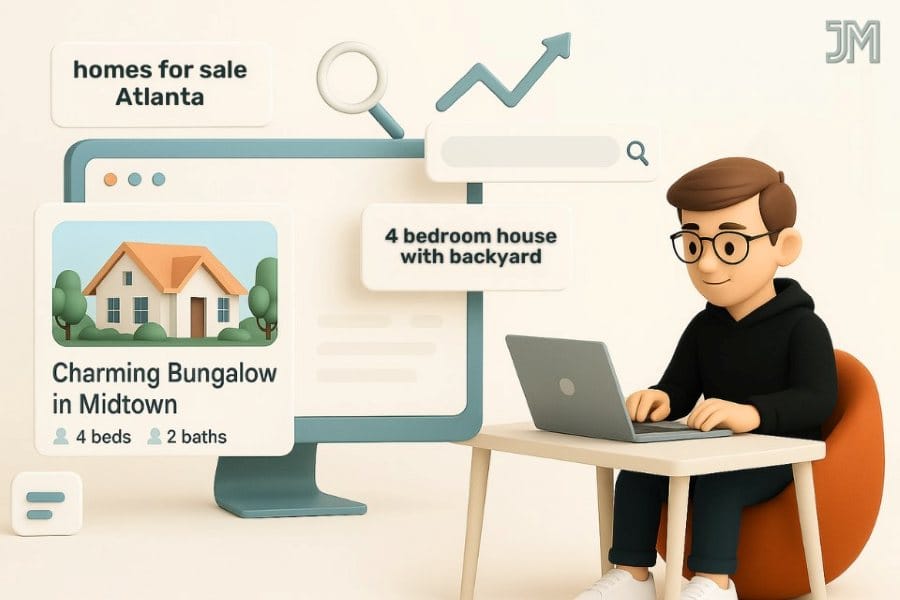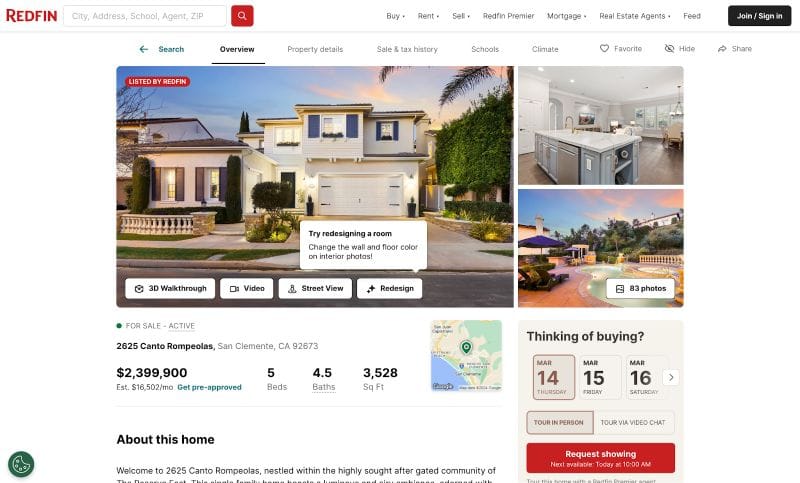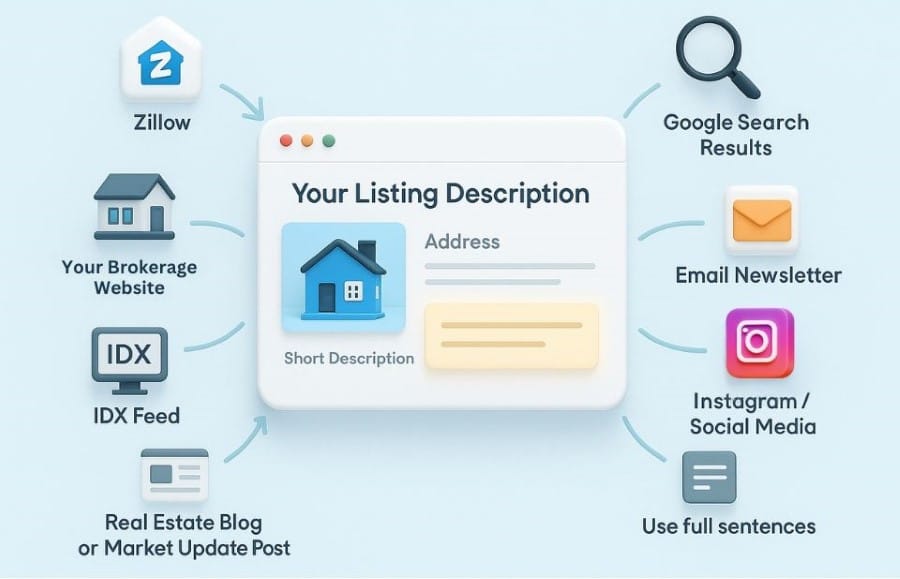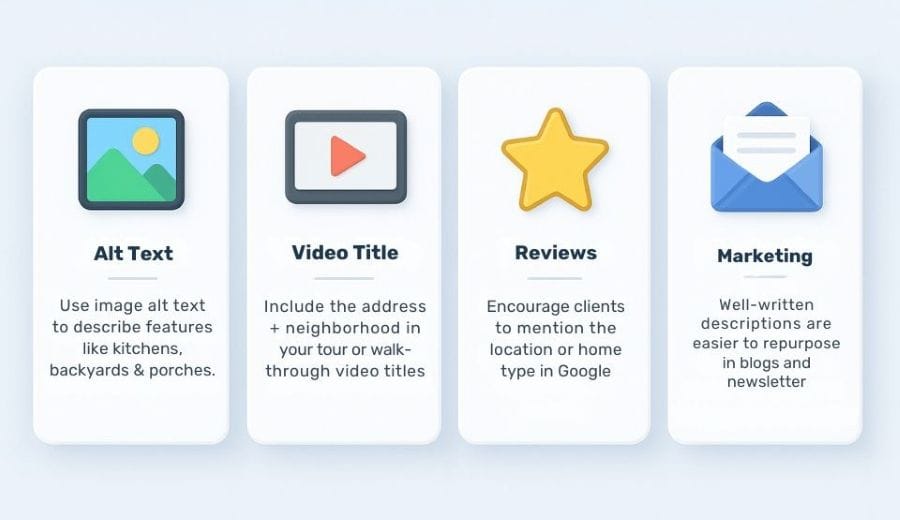
Most real estate agents don’t think about SEO when they’re writing a listing. Why would they?
You enter the property details, upload the photos, write the listing description, and let the brokerage or MLS handle the rest. Right?
Here’s the truth: your listing description might be the only part of your real estate website you actually control, and it plays a huge role in whether your listing shows up in Google.
Even if you don’t manage your own website, you can still influence how your listings appear online. That one paragraph you write gets syndicated everywhere: your brokerage site, Zillow, Realtor.com, IDX feeds, newsletters, social media posts.
And Google sees all of it.
If the copy is vague or generic, it blends in with hundreds of other listings. But if it’s specific, descriptive, and keyword-aware? That’s when people find you, and your property.
Let’s talk about how to write listing descriptions that help you stand out in search results.
Why your listing description matters

It’s easy to assume SEO is something the marketing department handles.
But your listing description is one of the few pieces of content that shows up everywhere, and the majority of the time, it’s pulled straight from the MLS with no changes.
Most real estate websites use an IDX feed that pulls your MLS data directly into a property page. That page typically includes your photos, basic details (like square footage, beds, and baths), and your listing description.
Google reads all of that.
But if every listing on that site uses the same cookie-cutter language, it’s hard for search engines to figure out what makes yours worth showing.
When you write thoughtful, specific listing copy, you give Google (and buyers) more to work with. You’re also helping your brokerages’ site, or wherever your listing lives, gain an edge against national portals like Zillow and Redfin, who also use your written description.
How Google sees a listing page
Google doesn’t know how beautiful the kitchen is. It doesn’t see the natural light, or the staging, or the way the backyard catches the sunset. All it sees is text, and that text tells it what the page is about.
On a listing page, the description you write is often the only custom text on the entire page. Everything else (property specs, price, square footage) is generated automatically.
If you want your listing to stand out in a sea of near-duplicates, that paragraph becomes your competitive advantage.

Here’s what Google is looking at:
The address and neighborhood in the page title
The URL structure (which you probably can’t control)
The meta description (often pulled from your listing description)
The on-page content – which, in most cases, is your listing description
So when your listing description says nothing more than “Charming home in a great location,” Google has no idea what kind of home it is, where it’s located, or who it might be a good fit for.
That doesn’t help the page rank and it certainly doesn’t help buyers find it.
The problem with generic listing copy
Let’s be honest: most listing descriptions sound like they were written by a robot trying to stay under the character limit.
“Stunning 4BR/3BA home in desirable neighborhood. Open floor plan. Gourmet kitchen. Great for entertaining!”
It’s vague. It’s forgettable. And worst of all, it doesn’t tell Google, or your buyer, anything unique.
Now try this instead:
“Renovated 4-bedroom home in Peachtree Hills with open-concept living, a quartz island kitchen, and a fenced backyard, just steps from Peachtree Battle Shopping Center.”
Similar word count. Very different impact.
You’ve added:
A specific neighborhood
Descriptive features buyers might actually Google
A local landmark that creates search relevance
This isn’t about cramming in keywords. It’s about giving Google (and people) a reason to pay attention.
SEO-friendly listing description tips

You don’t need to be an SEO specialist to write better listing descriptions, you just need to think like your buyer.
What are they searching for? What features would they actually type into Google? And how can you work those naturally into the description?
Here are a few practical ways to level up your listing copy without sounding robotic:
1. Mention the neighborhood (naturally)
Always name the neighborhood or community when you can.
Not just “a great location” – actually say it.
Instead of: “Charming home in a great area.”
Try: “This Brookhaven home sits on a quiet, tree-lined street near Murphey Candler Park.”
Neighborhood names help search engines associate your listing with specific local queries, especially valuable for long-tail searches like “homes for sale in Brookhaven near parks.”
2. Use features buyers actually search
“Beautiful kitchen” is meaningless. “Quartz countertops,” “gas range,” or “oversized island” are search terms. Use the words your buyer would type.
Say: “Renovated primary bath with double vanities and frameless glass shower.”
Not: “Updated bathroom.”
Buyers often search for very specific features, and every time you name one clearly, you boost your chances of being found.
3. Include local landmarks, schools or walkability
If the home is zoned for a desirable school or near a landmark, mention it. These phrases carry weight in both search engines and buyer decision-making.
- “Walkable to East Atlanta Village”
- “Zoned for Morningside Elementary”
- “Just two blocks from the BeltLine”
4. Write in full sentences, not just a feature list
Avoid dumping a bunch of features with no flow. Google prefers natural language, and so do humans.
Good: “Step inside to find hardwood floors, a bright living room with fireplace, and a spacious screened porch overlooking the backyard.”
Meh: “Hardwoods. Fireplace. Screened porch. Large yard.”
A well-written description won’t just get your listing more clicks. It helps it actually show up in the first place.
How better descriptions help you stand out across platforms

Your listing description doesn’t just live on your MLS. It travels.
The moment you hit publish, that text is syndicated across your brokerage’s website, Zillow, Realtor.com, Homes.com, social media feeds, newsletters, email alerts, and IDX-powered sites all over the web.
And on many of those platforms, your listing description is the only thing that makes the listing stand out.
Same photos. Same price. Same stats.
So what’s going to make someone click your listing instead of the one above or below it?
A clear, engaging first sentence that makes people pause mid-scroll
Location-specific phrasing that aligns with what buyers are searching
Unique, descriptive copy that doesn’t feel copy-pasted from 50 other homes
And when your brokerage runs a blog post or newsletter titled “5 Homes With Great Outdoor Living in East Cobb,” guess which listing gets featured? Not the one that says “Great backyard!” but the one that says:
“Enjoy spring evenings on the screened porch, overlooking a private, fenced backyard with room to garden or entertain.”
Better descriptions give your listings legs.
They’re more shareable. More clickable. And more likely to get picked up when your marketing team, or Google, chooses what to feature.
Extra SEO moves (that don’t take much effort)

If you’ve nailed the description, you’re already ahead.
But there are a few more small things agents can do that quietly boost visibility, without needing to touch a single line of code.
1. Use alt text on photos (if your platform allows it)
When you upload listing photos, some MLS systems or brokerage platforms let you add alt text or captions. Use them wisely.
Alt text example: “Bright kitchen with quartz island and farmhouse sink in Grant Park home.”
Google uses this info to understand what the image is. It’s also a bonus for accessibility.
2. Title your virtual tours or videos with the address + neighborhood
If you’re uploading a Matterport tour, drone video, or walkthrough to YouTube or Vimeo, give it a title like:
Example: “Tour: 123 Main Street – Renovated Home in Kirkwood, Atlanta GA”
It sounds small, but it helps with video search and makes your content more discoverable.
3. Encourage clients to leave reviews that mention location
When asking for a review, you might say:
“If you’re comfortable, feel free to mention the neighborhood or the type of home we helped you buy. It really helps others find me.”
A review that says “Joel helped us find a townhome in Grant Park near the BeltLine” gives Google more to associate with your name.
4. Send your listings to your marketing team early
If you’re part of a brokerage with a content or social media team, better descriptions make it easier for them to promote your listing in blogs, email campaigns, or Instagram features.
That extra exposure = extra SEO juice.
You have more SEO power than you think
Most agents assume SEO is someone else’s responsibility, something handled by the brokerage, the website provider, or the “tech people.”
But here’s the truth: your words are what show up in search.
You don’t need access to backend code or a degree in digital marketing. If you can write a listing description, you can influence whether your property gets found.
That one paragraph doesn’t just describe the home. It fuels the MLS, the website, the email blast, the social post, the blog highlight, and yes, even the search engine result.
So skip the generic lines. Be specific. Use the neighborhood name. Call out real features buyers actually want. Think about what someone would type into Google, and then answer that search before they even ask.
That’s what turns your listing from just another address… into something worth clicking.
Want help writing SEO-friendly listing descriptions or improving the visibility of your current listings? Let’s connect.
Let’s grow your traffic together
Have an SEO question or need help with a project? Whether you’re a small business or a national brand, I’ll help you rank higher and convert more.
